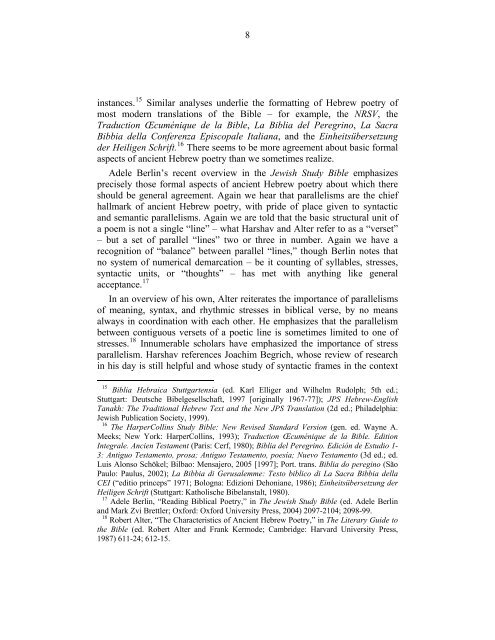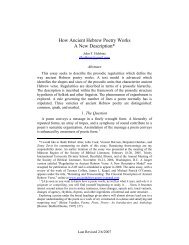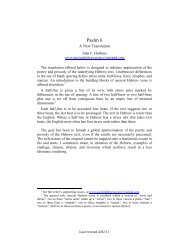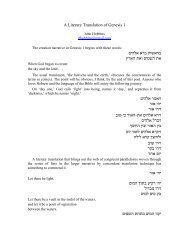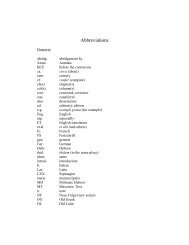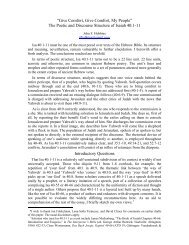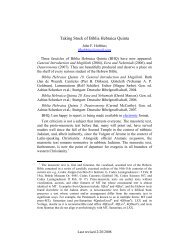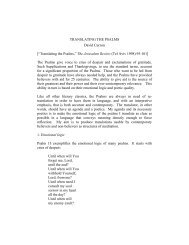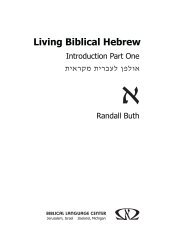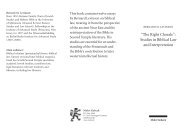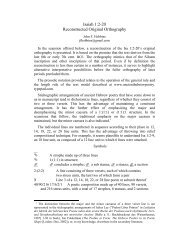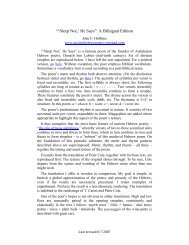Here - Ancient Hebrew Poetry - Typepad
Here - Ancient Hebrew Poetry - Typepad
Here - Ancient Hebrew Poetry - Typepad
- No tags were found...
You also want an ePaper? Increase the reach of your titles
YUMPU automatically turns print PDFs into web optimized ePapers that Google loves.
8instances. 15 Similar analyses underlie the formatting of <strong>Hebrew</strong> poetry ofmost modern translations of the Bible – for example, the NRSV, theTraduction Œcuménique de la Bible, La Biblia del Peregrino, La SacraBibbia della Conferenza Episcopale Italiana, and the Einheitsübersetzungder Heiligen Schrift. 16 There seems to be more agreement about basic formalaspects of ancient <strong>Hebrew</strong> poetry than we sometimes realize.Adele Berlin’s recent overview in the Jewish Study Bible emphasizesprecisely those formal aspects of ancient <strong>Hebrew</strong> poetry about which thereshould be general agreement. Again we hear that parallelisms are the chiefhallmark of ancient <strong>Hebrew</strong> poetry, with pride of place given to syntacticand semantic parallelisms. Again we are told that the basic structural unit ofa poem is not a single “line” – what Harshav and Alter refer to as a “verset”– but a set of parallel “lines” two or three in number. Again we have arecognition of “balance” between parallel “lines,” though Berlin notes thatno system of numerical demarcation – be it counting of syllables, stresses,syntactic units, or “thoughts” – has met with anything like generalacceptance. 17In an overview of his own, Alter reiterates the importance of parallelismsof meaning, syntax, and rhythmic stresses in biblical verse, by no meansalways in coordination with each other. He emphasizes that the parallelismbetween contiguous versets of a poetic line is sometimes limited to one ofstresses. 18 Innumerable scholars have emphasized the importance of stressparallelism. Harshav references Joachim Begrich, whose review of researchin his day is still helpful and whose study of syntactic frames in the context15 Biblia Hebraica Stuttgartensia (ed. Karl Elliger and Wilhelm Rudolph; 5th ed.;Stuttgart: Deutsche Bibelgesellschaft, 1997 [originally 1967-77]); JPS <strong>Hebrew</strong>-EnglishTanakh: The Traditional <strong>Hebrew</strong> Text and the New JPS Translation (2d ed.; Philadelphia:Jewish Publication Society, 1999).16 The HarperCollins Study Bible: New Revised Standard Version (gen. ed. Wayne A.Meeks; New York: HarperCollins, 1993); Traduction Œcuménique de la Bible. EditionIntegrale. Ancien Testament (Paris: Cerf, 1980); Biblia del Peregrino. Edición de Estudio 1-3: Antiguo Testamento, prosa; Antiguo Testamento, poesía; Nuevo Testamento (3d ed.; ed.Luis Alonso Schökel; Bilbao: Mensajero, 2005 [1997]; Port. trans. Biblia do peregino (SãoPaulo: Paulus, 2002); La Bibbia di Gerusalemme: Testo biblico di La Sacra Bibbia dellaCEI (“editio princeps” 1971; Bologna: Edizioni Dehoniane, 1986); Einheitsübersetzung derHeiligen Schrift (Stuttgart: Katholische Bibelanstalt, 1980).17 Adele Berlin, “Reading Biblical <strong>Poetry</strong>,” in The Jewish Study Bible (ed. Adele Berlinand Mark Zvi Brettler; Oxford: Oxford University Press, 2004) 2097-2104; 2098-99.18 Robert Alter, “The Characteristics of <strong>Ancient</strong> <strong>Hebrew</strong> <strong>Poetry</strong>,” in The Literary Guide tothe Bible (ed. Robert Alter and Frank Kermode; Cambridge: Harvard University Press,1987) 611-24; 612-15.


